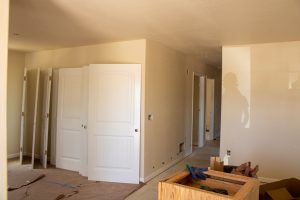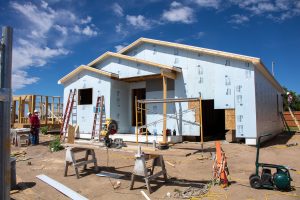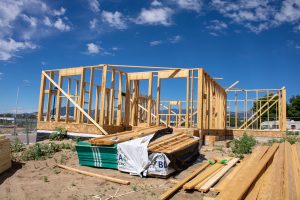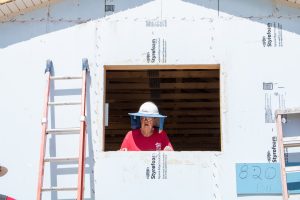 At Pikes Peak Habitat for Humanity, we’ve transitioned to building homes that are fully electric (rather than relying on a combination of electricity and natural gas). We’ve made this shift for multiple reasons–to make homes safer, keep utility bills lower for our homeowners, and focus on more sustainable energy. But that raises questions Pikes Peak Habitat Construction Superintendent Eric Wells recently addressed: Is electricity really more sustainable? What innovations are increasing our capacity to make electricity more renewable?
At Pikes Peak Habitat for Humanity, we’ve transitioned to building homes that are fully electric (rather than relying on a combination of electricity and natural gas). We’ve made this shift for multiple reasons–to make homes safer, keep utility bills lower for our homeowners, and focus on more sustainable energy. But that raises questions Pikes Peak Habitat Construction Superintendent Eric Wells recently addressed: Is electricity really more sustainable? What innovations are increasing our capacity to make electricity more renewable?
Here’s what Wells shares:
 “Most of the electricity these days is created from burning fossil fuels, whether it’s coal or natural gas. More and more renewable energy-generating resources are coming online, like solar or wind, which eventually will replace burning these fuels.
“Most of the electricity these days is created from burning fossil fuels, whether it’s coal or natural gas. More and more renewable energy-generating resources are coming online, like solar or wind, which eventually will replace burning these fuels.
The biggest thing that I think is very exciting and may be overlooked is the ability to store electricity. We can generate more electricity through solar panels during the day, for example, that may not be used, and unfortunately that goes to waste; we can’t currently store it. But if we figure out mass storage for the excess electricity, then it’s like, game over; we’re good; we can make this happen now. I think that the cutting-edge focus is on is electrical storage. What’s neat is that there are so many ways that are being developed to actually do that, especially here in Colorado.
 Storing excess electricity is a game-changer. Power generators, like coal or natural gas plants, can’t instantly respond to power demand changes. They have to predict how much power is needed for the next day and then slowly ramp up or down the power generation to supply. However, if the power demand is more than they predicted — for example, a day is much hotter than forecasted, so people are using more power to cool their homes or businesses — then brownouts or blackouts can occur. Being able to store electricity would go far to eliminate these issues, since the utilities will have the option to tap into that storage when power-generating shortfalls happen.
Storing excess electricity is a game-changer. Power generators, like coal or natural gas plants, can’t instantly respond to power demand changes. They have to predict how much power is needed for the next day and then slowly ramp up or down the power generation to supply. However, if the power demand is more than they predicted — for example, a day is much hotter than forecasted, so people are using more power to cool their homes or businesses — then brownouts or blackouts can occur. Being able to store electricity would go far to eliminate these issues, since the utilities will have the option to tap into that storage when power-generating shortfalls happen.
The first thing to think about is battery storage. The first generation of electric vehicles are nearing the end of their useful life on the roads, because their battery capacity is reduced to about 80% of the original. Those batteries can be taken out of the cars, put into a stationary building, and used to store the excess generated electricity.
Sand can even be used as a battery. There are several projects around the world that dump excess heat into a huge container of sand. Heat is transferred into water pipes, and the pipes run through the container of sand, transferring heat into it. The sand retains that heat for days. The whole process can be reversed by running water in pipes back through the hot sand, which will transfer its heat into the water, which in turn will be used to turn a turbine and generate heat.
 If we have excess energy during the day, we can use that to pump water up to a higher reservoir, and then during the times when we need more electricity, we can release that water, just like a hydroelectric dam, and generate electricity for us in a lower reservoir. The extra generated energy drives a motor that pulls a giant weight up into the air or up an incline, and then when we need to generate more electricity, that weight can be allowed to fall and turn a motor, which will generate electricity. Here in Colorado, we are so lucky to have the elevation changes that are needed for these kinds of ideas. But in places that don’t have natural elevation changes, it wouldn’t be difficult to build these structures with heavy weights in the flatter geographical areas, such as the Colorado plains.”
If we have excess energy during the day, we can use that to pump water up to a higher reservoir, and then during the times when we need more electricity, we can release that water, just like a hydroelectric dam, and generate electricity for us in a lower reservoir. The extra generated energy drives a motor that pulls a giant weight up into the air or up an incline, and then when we need to generate more electricity, that weight can be allowed to fall and turn a motor, which will generate electricity. Here in Colorado, we are so lucky to have the elevation changes that are needed for these kinds of ideas. But in places that don’t have natural elevation changes, it wouldn’t be difficult to build these structures with heavy weights in the flatter geographical areas, such as the Colorado plains.”

